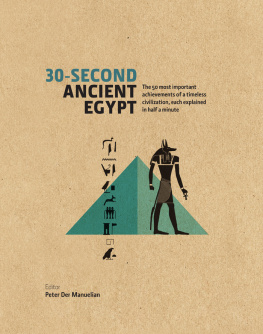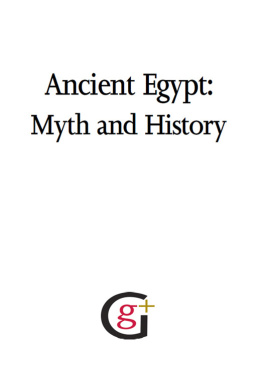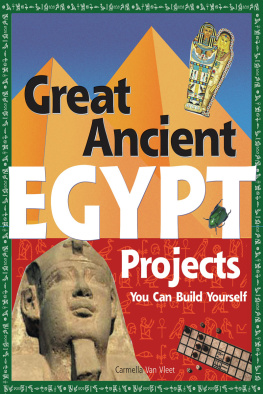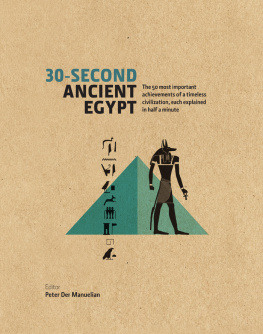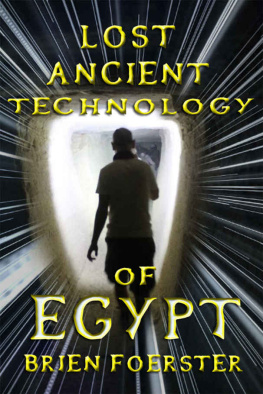
30-SECOND
ANCIENT EGYPT
The 50 most important achievements of a timeless civilization, each explained in half a minute
Editor
Peter Der Manuelian
Contributors
Rachel Aronin
Marianne Eaton-Krauss
Ronald J. Leprohon
Peter Der Manuelian
Nicholas Picardo
Thomas Schneider

Weve all heard of pyramids, hieroglyphs and Cleopatra, but how much do you really know about ancient Egypt? Why was the Nile integral to the unification of Egypt? What is the mystery surrounding Queen Hetepheres tomb? What did the Amarna Letters reveal? What did the ancient Egyptians eat and drink?
30-Second Ancient Egypt presents a unique insight into one of the most brilliant and beguiling civilizations, where technological innovations and architectural wonders emerge among mysterious gods and burial rites. Each entry is summarized in just 30 seconds using nothing more than two pages, 300 words and a single picture. From royal dynasties and Tutankhamuns tomb, to hieroglyphs and mummification, interspersed with biographies of Egypts most intriguing rulers, this is the quickest path to understanding the 50 key ideas and innovations that developed and defined one of the worlds great civilizations.
CONTENTS
INTRODUCTION
Peter Der Manuelian
Pyramids, mummies, King Tut, Cleopatra, and of course the mysterious code of Egyptian hieroglyphs. These are the icons embedded in Western popular culture, the first to spring to mind when the topic of ancient Egypt arises. And why not? Try to find another civilization with the megalomania to match the pyramids of 4,500 years ago. Or one that has found such an impressive way to conquer death and decay magically by preserving the human form over millennia. Has any archaeological discovery topped the 1922 find of Tutankhamuns tomb in the Valley of the Kings? The multitalented Cleopatra, who navigated treacherous political waters and won the love of two Roman leaders, never ceases to fascinate us. And finally, the Egyptians use of birds, objects, and striding human figures to represent verbs, nouns, and adjectivesthe building blocks of a full-fledged grammatical languagesurely comprises one of the most intriguing examples of art as writing, and writing as art.

Bust of Nefertiti
The elegant bust of Nefertiti, wife of the pharaoh Akhenaten, is one of the most iconic sculptures of ancient Egypt (see ).
But ancient Egypt, and the scholarly discipline of Egyptology, have so much more to offer beyond the headline icons listed above. The questions we explore are as endless as they are fascinating. How did the Nile Valley become home to one of the most sophisticated and durable complex societies in human history? Where did this pharaonic state, with its all-important concept of kingship, and a labyrinthine administration that would bring a smile to any modern bureaucrats lips, come from? Why did illiterate peasants in distant villageswho would never see the pharaoh or the capitalbuy in to the system? What role did the geography and climate play in defining Egypts relationship with her neighbors to the south, west, and northeast? How did the writing system evolve, from tags and simple identifiers to didactic treatises on social behavior, philosophical musings on the nature of existence, biographical inscriptions, mortuary spells, gynecological texts, and court trial records of captured tomb robbers? What drove a nation to construct a temple complex that is larger than the Vatican, each king striving to outshine his predecessor with pylons, columned halls, and sacred spaces? When and why did the Egyptians create their unique blend of frontal and profile perspectives, combining the best of all vantage points and leading to an art style that is instantly recognizable, from Horus and Hapi to Heston and Hollywood? These are just a few of the many topics that you will find in this book, summarized and described in accessible overviews by distinguished Egyptologists from around the world. As we learn ever more about ancient life along the Nile, today the field of Egyptology includes methodologies from anthropology, archaeology, history, biology philology, linguistics, geology, statistics, art history, digital humanities, and social studies, to name just a few.

The Pyramids of Giza
These colossal structures are testament to the technological brilliance of the ancient Egyptians. The pyramid on the rightthe Great Pyramid of Gizais the only surviving Wonder of the Ancient World (see ).
Chapter and Verse
Modern approaches to ancient Egyptian civilization tend to divide elements of the culture into categories that the ancients would not have recognized. For example, we might distinguish between magic and science, between church and state, but the Egyptians wove such concepts into a seamless world view. Nevertheless, this book presents seven chapters, each full of information on such specific themes. We begin with Land & People, covering the Nile, surrounding landscape and peoples, kingship and the succession of royal dynasties. We then move into Architecture & Sites, summarizing the various forms of Egyptian construction, and highlighting some of the most important sites and structures. Because the history of Egyptian archaeology is as fascinating as the finds themselves, our next chapter covers some of the Great Discoveries, including hidden mummies of pharaohs we never expected to meet in person, golden treasures, artistic masterpieces, an international correspondence archive, a mysterious royal tomb, and thousands of statues from a single temple pit. From here, we shift the focus to many aspects of Egyptian society, professional life, and thought. Science, Medicine & Technology takes us into the realm of the technicians, while Thought & Belief reveals Egyptian religion and the mortuary realm. Sculpture, painting, and the world of letters are the subject of Art & Culture, while our final chapter looks at Life & Society, from family roles and relations to food preparation and bureaucratic administration. Sprinkled throughout the chapters are special two-page biographies that illuminate the lives and careers of some of ancient Egypts most intriguing individuals.

Pottery vessels
The ancient Egyptians excelled at many crafts, producing fine ceramics and pottery for everyday use as well as for ceremonial purposes.

Sites of ancient Egypt
This map shows some of the most significant ancient sites and modern cities (the country borders are modern).
How to use this book
Throughout the volume, you will find each subject contained on a single left-hand page, with selected imagery on the right-hand page. The main entry, the 30-second history, provides the most in-depth treatment of the topic. In the margin at left, the 3-second survey encapsulates the topic in a single sentence and, farther below, the 3-minute excavation elaborates on the theme, with additional evidence, or a sidebar anecdote or specific example. To the right, Related histories cross-reference to other topics in the book, while 3-second biographies list relevant individuals, ancient or modern, with significant connections to the theme under discussion. There is a Resources section at the back of the book providing some excellent suggestions for further reading, as well as a number of Egyptological web sites on a wide variety of topics. Taken together, the volume aims to provide glimpses into the rich cultural legacy of the ancient Egyptians, while presenting the equally remarkable development of the field of Egyptology.
Next page
